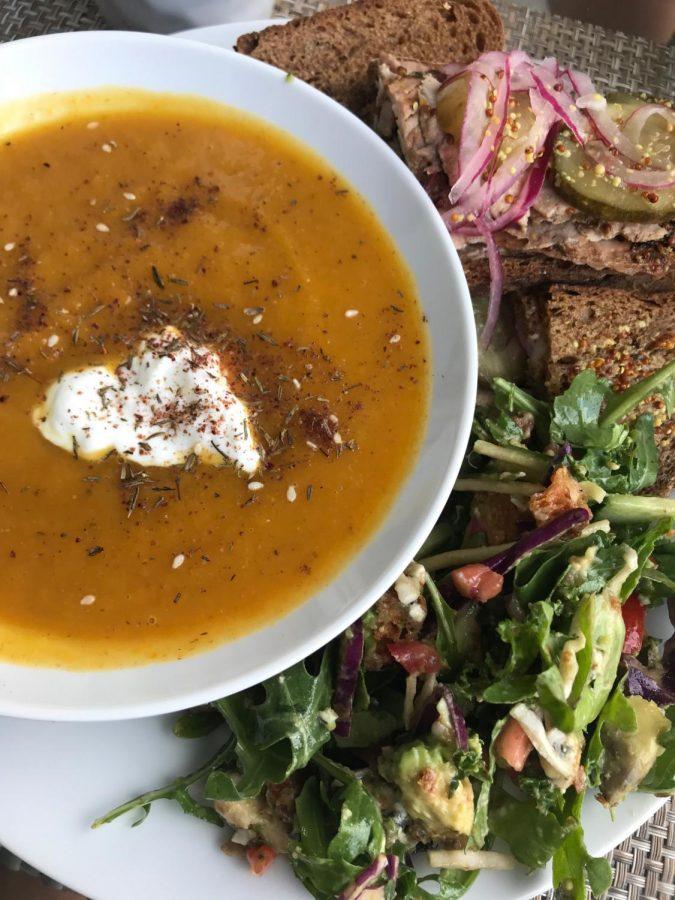Comfort foods are satisfying and can be healthful, too
Published August 20, 2020
There is simplicity and an unspoken elegance inherent in most comfort foods. Every culture has them. They are the foods that console us and make us feel good.
Here in America, popular comfort foods include gooey mac ’n’ cheese, beef stew with noodles or dumplings, chicken noodle soup, shepherd’s pie and baked lasagna.
Likewise, many traditional Jewish dishes fall into that same category: rich chicken soup and kneidlach, cheesy lokshen kugel, oniony kasha varnishkes, hamin (a stew of potatoes carrots, wheat berries and chickpeas) and, of course, cholent, that Shabbat stew made from potatoes, beans and barley that’s left to cook overnight in a low-temperature oven and ready just in time for lunch after synagogue services.
ADVERTISEMENT
And though we might be tempted to think of comfort foods as ones served on cold wintry nights or for special holiday meals, there are no such rules. In fact, I can’t think of a more perfect time than now for healthy comfort foods that are easy to prepare from humble ingredients.
Beans, lentils and whole grains are the humble ingredients I am referring to. These are ingredients from which healthy and satisfying meals can be made. The possibilities are limitless. I have been keeping a food journal since the start of this pandemic and, in looking over those entries, I realized that many of our favorite dishes are made with, you guessed it, beans, lentils and grains.
We’ve had red lentil soup with Middle Eastern spices; skirt steak and black bean chili over creamy polenta; Thai vegetable red curry over brown rice; stewed cannellini beans with fresh herbs, African peanuts and chickpea stew; poblano peppers stuffed with quinoa and grilled corn; farro salad with arugula, sweet potatoes and dates; wild rice salad with fresh peaches and pecans; and tabbouleh salad.
So what makes beans, lentils and whole grains so healthy, and why does eating them bring us comfort?
ADVERTISEMENT
First, let’s consider the health benefits. Beans, lentils and whole grains are carbohydrates, as are most of the foods we think of as comfort foods. Carbohydrates are foods with naturally occurring sugars and starches that provide energy to our brains, muscles and organs.
But not all carbohydrates are healthy. Beans, lentils and whole grains are complex carbohydrates, meaning they also contain fiber, which must first be broken down by our digestive systems before being absorbed into our bodies. That process keeps our systems running smoothly and prevents a spike in blood sugar.
By contrast, white rice or anything made from white flour such as many breads, cakes, cookies and pastas, have had the source of fiber removed. These are known as simple carbohydrates, an abundance of which can cause a rapid rise in blood sugar. As a result, we crave more simple carbohydrates, making us more susceptible to gaining weight and developing Type 2 diabetes.
Second, let’s consider why foods high in carbohydrates give us this comfort. Carbohydrates raise our level of serotonin, which is the chemical in our brains that acts as a feel-good mood regulator. Whenever we feel stressed, it is natural to crave foods that comfort us. Of course, too many bowls of mac ’n’ cheese or too many cookies can raise more than just our serotonin levels. That is why eating complex carbohydrates such as beans, lentils and whole grains are good for both our physical and mental health.
But I’m not a member of the food police. I, too, love an occasional bowl of mac ’n’ cheese or lokshen kugel which, by the way, can be made healthier by using whole wheat pastas. And that fondness is not merely the chemistry of the carbs but the warm memories of sharing those foods with special friends and family.
I have included two recipes below with several ingredient options, making them easier to prepare with foods you may already have in your pantry and refrigerator. Both the salad and the soup can be prepared a day in advance and kept refrigerated. They can be served warm or at room temperature. Accompanied by a salad and a slice of whole grain bread, both dishes would make a healthy and delicious meal.
Margi Lenga Kahn is the mother of five and grandmother of seven. A cooking instructor at the Kitchen Conservatory, she is working on a project to preserve the stories and recipes of heritage cooks. She welcomes your comments and suggestions at [email protected].
Red Lentil Soup with Middle Eastern Spices
Ingredients
- 2 tbsp. extra-virgin olive oil
- 2 medium yellow onions, peeled and coarsely chopped
- 4-5 cloves garlic, peeled and minced
- 2 celery stalks, coarsely chopped
- 1½ tsp. salt, plus more as needed
- ½-1 tsp. freshly ground black pepper
- 1 tsp. ground turmeric
- 1¼ tsp. ground cumin
- Optional spices: pinch of cayenne pepper, saffron, za’atar or ground coriander
- 6 c. vegetable or chicken stock (or water), or more as needed
- 1 c. red lentils, rinsed
- 1 14.5 oz. can chopped tomatoes (or 2 tomatoes, peeled and chopped)
- 1 carrot, trimmed, scraped and coarsely chopped
- ½ tsp. freshly squeezed lemon juice (optional)
Garnish
- ¼ c. yogurt, sour cream or crème fraiche
- 1 tbsp. za’atar, dried oregano or toasted cumin seeds
- ¼ c. coarsely chopped Italian parsley or cilantro (optional)
Directions
- Heat olive oil in a large heavy pot over medium heat. Add onions, garlic and celery; sauté, stirring occasionally, until softened but not browned.
- Add salt, pepper, turmeric, cumin and any of the optional spices, if desired. Cook, stirring often, for two to three minutes.
- Add broth or water, lentils, carrots and tomatoes; bring mixture to a boil. Lower heat, cover pan and simmer soup for 30-35 minutes, checking after 20 minutes and adding more broth or water to keep mixture soupy.
- Remove pot from heat. Uncover and let cool. Use an immersion blender or carefully transfer to a blender to puree. Stir in lemon juice and taste, adding more salt and pepper, as needed
- Ladle soup into bowls and dollop each with sour cream. Sprinkle with one of the suggested spices and parsley.
Makes 4-6 servings.
Seasonal Wild Rice Salad
Ingredients
- 1 c. wild rice, well rinsed and drained (farro, brown rice, kamut or wheat berries are good substitutes)
- 4 c. cold water
- 1½ tsp. coarse kosher salt, divided, plus more as needed
- ½ tsp. finely grated orange zest (or lemon zest)
- ¼ c. freshly squeezed orange juice (or pomegranate juice)
- ¼ c. extra virgin olive oil
- 3 tbsp. apple cider vinegar (or white wine vinegar)
- 2 tbsp. honey (or maple syrup or agave syrup)
- 1¼ tsp. Dijon mustard
- ¼ tsp. freshly ground black pepper, plus more as needed
- 1 c. pecans, toasted and coarsely chopped (or walnuts or pistachios)
- ½ c. dried blueberries (or dried cranberries, dried cherries, dried snipped apricots or a combination)
- ½ c. chopped flat leaf parsley, plus more for garnishing
- 2 peaches, pits removed and peaches cut into 1-inch pieces (or oranges, apples, nectarines or apricots)
- ¼ c. toasted pumpkin seeds (or toasted sunflower seeds)
- ¼ c. finely minced red onion (or green onions or shallots)
Directions
- Combine rice, water and 1 tsp. salt in a medium saucepan. Bring mixture to a boil, cover with a lid and reduce heat to a simmer. Simmer mixture for 50-55 minutes, or until rice grains are just tender, but not mushy. Strain rice, discarding excess liquid. Set rice aside to cool.
- In a large serving bowl, whisk together zest, orange juice, oil, vinegar, honey, mustard, pepper and remaining ½ tsp. salt.
- Layer rice, pecans, dried blueberries, parsley, peaches, pumpkin seeds and red onions. Toss together, spooning from the bottom up to incorporate the dressing, until ingredients are evenly mixed. Taste, adding more salt and pepper, as needed. Garnish with chopped parsley and serve.
Makes 6-8 servings.
















